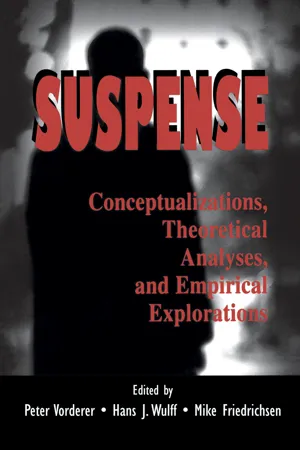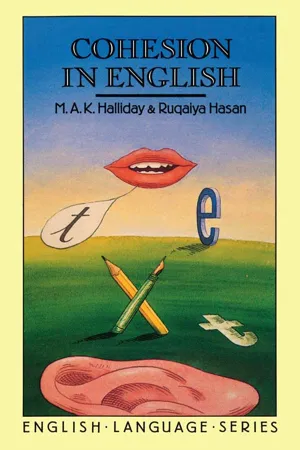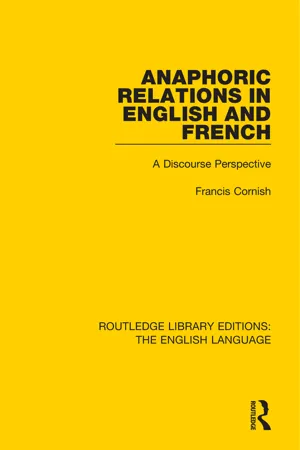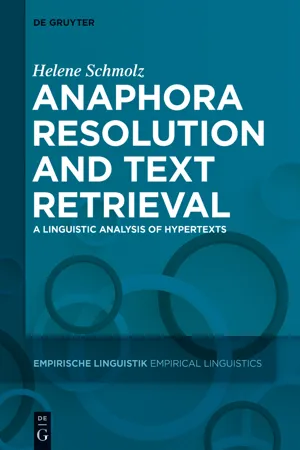Languages & Linguistics
Cataphoric Reference
Cataphoric reference is a linguistic phenomenon where a word or phrase refers to something mentioned later in the discourse. It is the opposite of anaphoric reference, which refers to something mentioned earlier. For example, in the sentence "When she arrived, Mary was tired," "she" is a cataphoric reference to "Mary," which is mentioned later in the sentence.
Written by Perlego with AI-assistance
4 Key excerpts on "Cataphoric Reference"
- eBook - ePub
Suspense
Conceptualizations, Theoretical Analyses, and Empirical Explorations
- Peter Vorderer, Hans Jurgen Wulff, Mike Friedrichsen(Authors)
- 2013(Publication Date)
- Routledge(Publisher)
Zeigemoment ), which is always present in cinematic speech, can be identified particularly clearly in them. At the same time, the cataphor is a manifestation of a textual instance, an authority that controls the action in such a way that it points to future developments. If one so wishes, this is a paradox: the advance reference aimed to a still open situative development. It is one of the conventions of storytelling that one only foreshadows things that actually happen, and that actually become a subject of the situation. The following course of events must, therefore, already be known before a cataphor can be installed.Let us refer to Bühler (1965) on anaphoric expression as he wrote in general about textual references: "There is a showing in the form of the anaphora; and whoever looks for the field of showing ('Zeigfeld') where it is happening, will find the ribbon of emergent speech itself being treated as a 'Zeigfeld.' The context is the anaphoric 'Zeigfeld,' the emergent speech becomes retrospective and prognostic in places, becomes reflexive " (p. 258). In two respects, this concept is important and puts in a nutshell the juxtaposition of a work's structure and the activity of reception that is so difficult to convey:- The staging of this field of reference, and thus of the movement of reception, is absolutely essential for the dramaturgy of suspense.
- The experience of suspense follows a strategy of referential showing and is thus always orientated to the text. Viewers cannot free themselves completely from the text—despite the importance that the workings of the imagination have for the experience of suspense. In fact, the viewers are always being led back into that domain of controlled information.
Narrative, Thematic, and Atmospheric Frameworks
Every narratively eventful storyline opens up a series of possible connections that each person who has mastered the laws of the genre or the rules of everyday life can calculate. Someone, for example, who steals some money, commits an offense, is sought after by the police (and possibly others). Another person, who finds some incriminating material that can send the highest echelons of a crime syndicate to prison, must be conscious of the fact that there will be an attempt to get the material back at any price. One can dispense with further examples here—it is clear that the way someone gets caught up in a story is almost identical to the way that one gets further into a field of complications, antagonisms, and the like. When the story gets going, the further developments can be extrapolated, at least in part, from what has already happened. - eBook - ePub
- M.A.K. Halliday, Ruqaiya Hasan(Authors)
- 2014(Publication Date)
- Routledge(Publisher)
We have distinguished this, in the previous discussion, from structural cataphora as in he who hesitates ; structural cataphora is very common, especially with the definite article (see 2.4.2 below), but it is simply a realization of a grammatical relationship within the nominal group and has no cohesive, text-forming function. Textual cataphora, by contrast, is true reference forward in the text; it therefore is cohesive, not by picking up what has preceded but by anticipating what is to follow. From Alice : [2:57] These were the verses the White Rabbit read: – [followed by the verses] In writing, sentences which are related cataphorically are often joined by a colon; but there is no structural relation between the two – this is a purely orthographic convention, serving precisely to signal the presence of cataphoric cohesion. A final point to note is that in spoken English this and that in extended reference often carry the tonic (primary stress). In this they are unlike all other cohesive items in the language. Since, in the most general terms, tonicity is associated with information that is new, it is not surprising to find that anaphoric items, which by definition are not ‘new’, because they are referring to what has gone before, do not normally carry the tonic. (The position is quite different with reference items used exophorically; these are often tonic – again, not surprisingly, since in this case the referent has not been mentioned before.) We can be quite precise about anaphoric items: they are tonic when and only when they are contrastive, and this is part of the same story. The semantic category of ‘new’ means ‘information being treated by the speaker as non-recoverable to the hearer’; it may be non-recoverable either because it has not been previously mentioned or because it has been previously mentioned but is unexpected and hence contrastive in the particular context - eBook - ePub
Anaphoric Relations in English and French
A Discourse Perspective
- Francis Cornish(Author)
- 2015(Publication Date)
- Routledge(Publisher)
4 , it is the verb or other predicate of which the anaphor is an argument or a 'modifier' within the anaphoric clause, together with the latter's 'referential' features (e.g. tense, aspect, modality and voice), which primarily determines its potential anaphoric reference, and hence its full contextual interpretation. What is predicated in context of the anaphor becomes especially crucial, of course, in instances where there is no available antecedent-trigger in the surrounding text (the case of so-called 'pragmatically controlled anaphora', or 'exophora'), or where contextual factors rule out the selection of a co-occurring candidate antecedent-trigger (cf,, for example, 4(13)-20)). The significance of what is predicated in context of the anaphor was highlighted most recently in the present work by the examples of French predicate anaphora in 4.2.2.2.1, namely 4(63)-(67), as well as the discussion of them on pages 128-129.It is clear, then, that reference and other discourse-related functions are of central importance in the operation of anaphora. The chief purposes of the present chapter are thus to determine certain referential and discourse parameters within which anaphora (particularly discourse anaphora) operates, to establish some of the discourse functions which certain types of anaphoric relations may perform, and to specify certain constraints which these appear to conform to.Section 1 examines the notion 'domain of reference, section 2 investigates the notion 'discourse referent' and its location within a discpurse model via a 'linguistic reflex'; section 3 discusses the relations between deixis and anaphora; and section 4 studies the anaphoric consequences of the relationship between the correlated categories of referential number and gender, as well as the distinction between clitic and non-clitic pronominal anaphora in French.5.1 The Notion ‘Domain of Reference’Reference is clearly a communicative function which is performed by speakers/writers in co-operation with their addressees, in terms both of some presupposed discourse context and of some specific, wider communicative goal. Anaphora, as was suggested in 5.0, is one means of constructing, maintaining or changing a domain of reference within a developing discourse model.The notion 'domain of reference' has been invoked, more or less precisely, under many different names in the literature on discourse. Grimes (1975:Ch.20.1), for instances, writes of the notion 'field of reference' which he appears to view as having a very broad scope, encompassing the construction by the speaker/writer of a homogeneous, internally consistent universe, whether fictional or factual. - eBook - ePub
- Helene Schmolz(Author)
- 2015(Publication Date)
- De Gruyter(Publisher)
Susan . It is quite common to use the term “antecedent” also for an expression to which a cataphor refers (cf. Stirling & Huddleston 2010: 1455; Quirk et al. 2012: 862). The term “postcedent” instead of “antecedent” is also found (cf. Baicchi 2004: 30; Sladovníková 2010: 71). The relationship between cataphor and antecedent is named cataphora. Cataphors tend not to be very frequent in texts. They occur only in specific circumstances and constructions, mostly as rhetoric devices in fiction and in journalism. There is one effect for which cataphors are particularly used: they can create suspense (cf. Jackson & Moulinier 2002: 179; Finch 2005: 201-202; Carter & McCarthy 2006: 245; Biber et al. 2007: 331).2.3.2 Endophora and exophora
Halliday & Hasan (2008: 31-37) subsume anaphors and cataphors under the category endophora, which they in turn distinguish from exophora. This categorisation of reference is visualised in Figure 1 .Fig. 1 : ReferenceAlthough both endophora and exophora constitute referential processes, they are different in one aspect fundamentally important for this work: whether the antecedents are found in the text or context. By definition, endophoric expressions have their point of reference in the text. Exophoric items, however, are references to the situation, so the referred item is retrievable from the verbal or nonverbal situation. It depends on the context, if an item has its point of reference in the surrounding text or in the situation, i.e. if this item is endophoric or exophoric. By reading or hearing only the sentence She likes music an outside observer does not know who she is. Yet, if a pointing gesture to the person who is meant by she accompanies this sentence in discourse, the reference is identifiable, and so it is exophoric. If the sentence Susan plays the piano precedes (see example (1)), the reference is endophoric. This also means that it is not an expression itself that is endophoric or exophoric, but the specific interpretation depends on the individual context. Some items, however, are nearly always endophoric, such as herself , or exophoric, such as here . Other items can usually be both endophoric or exophoric, depending on the context, such as this
Index pages curate the most relevant extracts from our library of academic textbooks. They’ve been created using an in-house natural language model (NLM), each adding context and meaning to key research topics.
Explore more topic indexes
Explore more topic indexes
1 of 6
Explore more topic indexes
1 of 4



